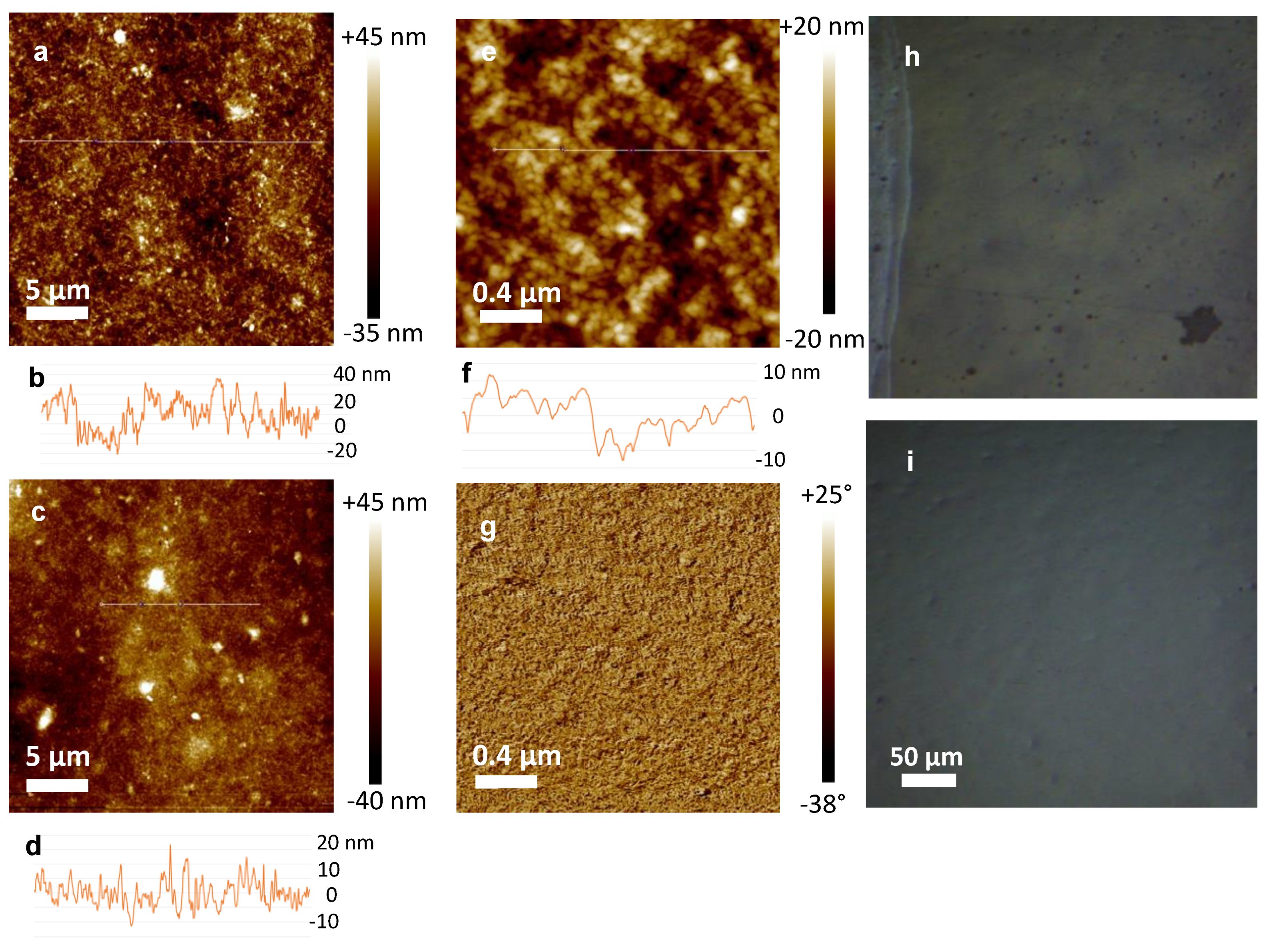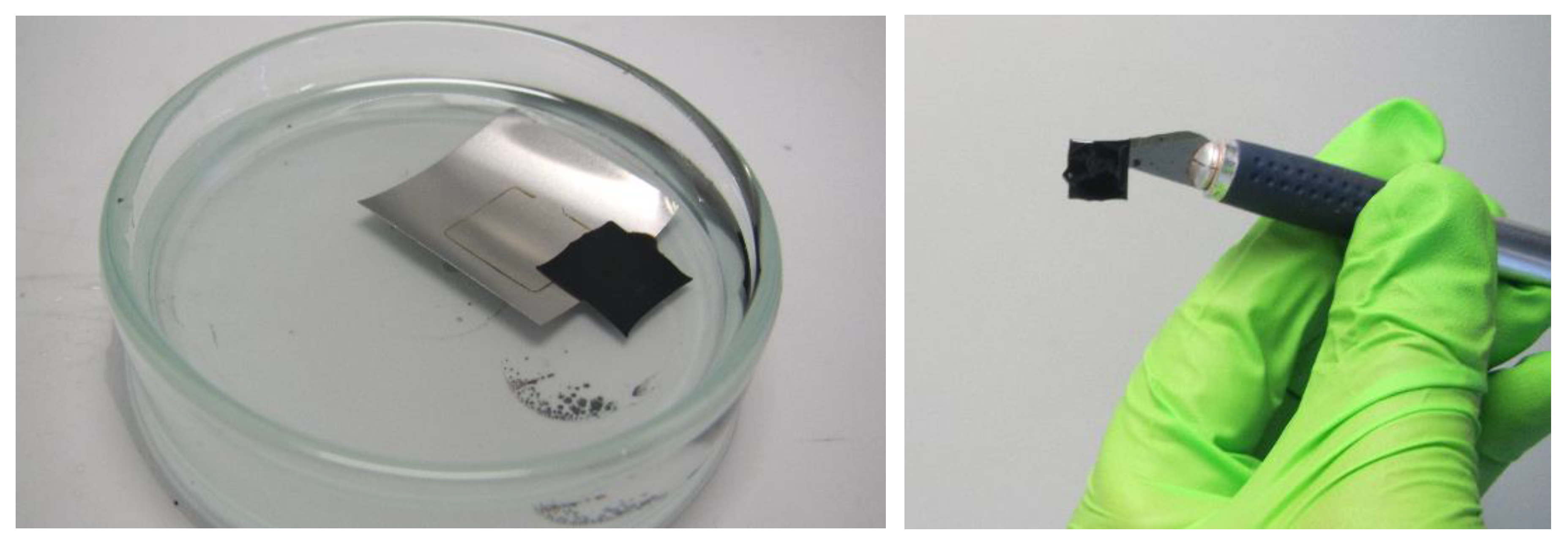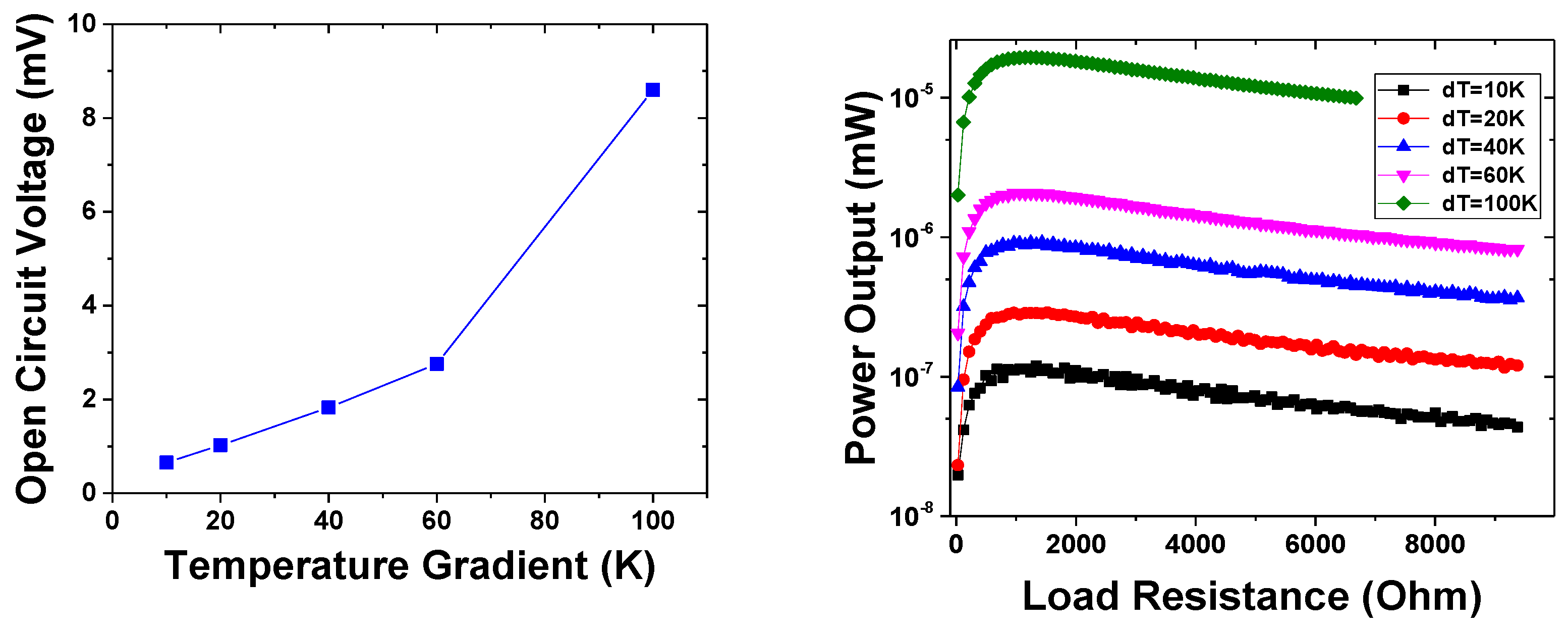A Printable Paste Based on a Stable n-Type Poly[Ni-tto] Semiconducting Polymer
Abstract
:1. Introduction
2. Materials and Methods
3. Results and Discussion
3.1. Polymer Development and Paste Preparation
3.2. Deposition: Dispense Printing
3.3. Film Properties
3.4. Thermoelectrical Generator Characterisation
4. Conclusions
Author Contributions
Funding
Acknowledgments
Conflicts of Interest
References
- Elmoughni, H.M.; Menon, A.K.; Wolfe, R.M.W.; Yee, S.K. A Textile–integrated polymer thermoelectric generator for body heat harvesting. Adv. Mater. Technol. 2019, 4, 1800708. [Google Scholar] [CrossRef]
- Han, S.; Alvi, N.U.H.; Granlöf, L.; Granberg, H.; Berggren, M.; Fabiano, S.; Crispin, X. A multiparameter pressure–temperature–humidity sensor based on mixed ionic–electronic cellulose aerogels. Adv. Sci. 2019, 6, 1802128. [Google Scholar] [CrossRef]
- Du, Y.; Xu, J.; Paul, B.; Eklund, P. Flexible thermoelectric materials and devices. Appl. Mater. Today 2018, 12, 366–388. [Google Scholar] [CrossRef]
- Fang, H.; Popere, B.C.; Thomas, E.M.; Mai, C.-K.; Chang, W.B.; Bazan, G.C.; Chabinyc, M.L.; Segalman, R.A. Large-scale integration of flexible materials into rolled and corrugated thermoelectric modules. J. Appl. Polym. Sci. 2017, 134, 9345. [Google Scholar] [CrossRef]
- Worfolk, B.J.; Andrews, S.C.; Park, S.; Reinspach, J.; Liu, N.; Toney, M.F.; Mannsfeld, S.C.B.; Bao, Z. Ultrahigh electrical conductivity in solution-sheared polymeric transparent films. Proc. Natl. Acad. Sci. USA 2015, 112, 14138–14143. [Google Scholar] [CrossRef]
- Gueye, M.N.; Carella, A.; Massonnet, N.; Yvenou, E.; Brenet, S.; Faure-Vincent, J.; Pouget, S.; Rieutord, F.; Okuno, H.; Benayad, A.; et al. Structure and dopant engineering in pedot thin films: Practical tools for a dramatic conductivity enhancement. Chem. Mater. 2016, 28, 3462–3468. [Google Scholar] [CrossRef]
- Wang, S.; Sun, H.; Erdmann, T.; Wang, G.; Fazzi, D.; Lappan, U.; Puttisong, Y.; Chen, Z.; Berggren, M.; Crispin, X.; et al. A chemically doped naphthalenediimide-bithiazole polymer for n-type organic thermoelectrics. Adv. Mater. Weinheim. 2018, 30, e1801898. [Google Scholar] [CrossRef]
- Orrill, M.; LeBlanc, S. Printed thermoelectric materials and devices: Fabrication techniques, advantages, and challenges. J. Appl. Polym. Sci. 2017, 134, 5147. [Google Scholar] [CrossRef]
- Tkachov, R.; Stepien, L.; Grafe, R.; Guskova, O.; Kiriy, A.; Simon, F.; Reith, H.; Nielsch, K.; Schierning, G.; Kasinathan, D.; et al. Polyethenetetrathiolate or polytetrathiooxalate Improved synthesis, a comparative analysis of a prominent thermoelectric polymer and implications to the charge transport mechanism. Polym. Chem. 2018, 9, 4543–4555. [Google Scholar] [CrossRef]
- Tkachov, R.; Stepien, L.; Roch, A.; Komber, H.; Hennersdorf, F.; Weigand, J.J.; Bauer, I.; Kiriy, A.; Leyens, C. Facile synthesis of potassium tetrathiooxalate – The “true” monomer for the preparation of electron-conductive poly(nickel-ethylenetetrathiolate). Tetrahedron 2017, 73, 2250–2254. [Google Scholar] [CrossRef]
- Faulmann, C.; Chahine, J.; Jacob, K.; Coppel, Y.; Valade, L.; de Caro, D. Nickel ethylene tetrathiolate polymers as nanoparticles: A new synthesis for future applications. J. Nanopart Res 2013, 15, 1953. [Google Scholar] [CrossRef]
- Oshima, K.; Shiraishi, Y.; Toshima, N. Novel nanodispersed polymer complex, poly(nickel 1,1,2,2-ethenetetrathiolate): Preparation and hybridization for n-type of organic thermoelectric materials. Chem. Lett. 2015, 44, 1185–1187. [Google Scholar] [CrossRef]
- Sun, Y.; Sheng, P.; Di, C.; Jiao, F.; Xu, W.; Qiu, D.; Zhu, D. Organic thermoelectric materials and devices based on p- and n-type poly(metal 1,1,2,2-ethenetetrathiolate)s. Adv. Mater. Weinheim. 2012, 24, 932–937. [Google Scholar] [CrossRef] [PubMed]
- Sun, Y.; Qiu, L.; Tang, L.; Geng, H.; Wang, H.; Zhang, F.; Huang, D.; Xu, W.; Yue, P.; Guan, Y.-S.; et al. Flexible n-Type high-performance thermoelectric thin films of poly(nickel-ethylenetetrathiolate) prepared by an electrochemical method. Adv. Mater. Weinheim. 2016, 28, 3351–3358. [Google Scholar] [CrossRef] [PubMed]
- Sun, Y.; Zhang, J.; Liu, L.; Qin, Y.; Sun, Y.; Xu, W.; Zhu, D. Optimization of the thermoelectric properties of poly(nickel-ethylenetetrathiolate) synthesized via potentiostatic deposition. Sci. China Chem. 2016, 59, 1323–1329. [Google Scholar] [CrossRef]
- Toshima, N.; Oshima, K.; Anno, H.; Nishinaka, T.; Ichikawa, S.; Iwata, A.; Shiraishi, Y. Novel hybrid organic thermoelectric materials:three-component hybrid films consisting of a nanoparticle polymer complex, carbon nanotubes, and vinyl polymer. Adv. Mater. Weinheim. 2015, 27, 2246–2251. [Google Scholar] [CrossRef] [PubMed]
- Wolfe, R.M.W.; Menon, A.K.; Fletcher, T.R.; Marder, S.R.; Reynolds, J.R.; Yee, S.K. Simultaneous enhancement in electrical conductivity and thermopower of n-type niett/pvdf composite films by annealing. Adv. Funct. Mater. 2018, 28, 1803275. [Google Scholar] [CrossRef]
- Chang, H.-P.; Cheng, K.L. A structural study of some metal diethyldithiocarbamate chelates by x-ray photoelectron spectroscopy. Spectrosc. Lett. 1981, 14, 795–807. [Google Scholar] [CrossRef]
- Jiao, F.; Di, C.-a.; Sun, Y.; Sheng, P.; Xu, W.; Zhu, D. Inkjet-printed flexible organic thin-film thermoelectric devices based on p- and n-type poly(metal 1,1,2,2-ethenetetrathiolate)s/polymer composites through ball-milling. Philos. Trans. A Math. Phys. Eng. Sci. 2014, 372, 20130008. [Google Scholar] [CrossRef]
- Menon, A.K.; Meek, O.; Eng, A.J.; Yee, S.K. Radial thermoelectric generator fabricated from n- and p-type conducting polymers. J. Appl. Polym. Sci. 2017, 134, 1457. [Google Scholar] [CrossRef]
- Menon, A.K.; Uzunlar, E.; Wolfe, R.M.W.; Reynolds, J.R.; Marder, S.R.; Yee, S.K. Metallo-organic n-type thermoelectrics: Emphasizing advances in nickel-ethenetetrathiolates. J. Appl. Polym. Sci. 2017, 134, 6829. [Google Scholar] [CrossRef]
- Menon, A.K.; Wolfe, R.M.W.; Marder, S.R.; Reynolds, J.R.; Yee, S.K. Systematic power factor enhancement in n-type niett/pvdf composite films. Adv. Funct. Mater. 2018, 28, 1801620. [Google Scholar] [CrossRef]
- Kang, J.S.; Kim, H.S.; Ryu, J.; Thomas Hahn, H.; Jang, S.; Joung, J.W. Inkjet printed electronics using copper nanoparticle ink. J. Mater. Sci. Mater. Electron. 2010, 21, 1213–1220. [Google Scholar] [CrossRef]
- Reynolds, J.R.; Karasz, F.E.; Lillya, C.P.; Chien, J.C.W. Electrically conducting transition metal complexes of tetrathio-oxalate. J. Chem. Soc. Chem. Commun. 1985, 268. [Google Scholar] [CrossRef]
- Reynolds, J.R.; Chien, J.C.W.; Lillya, C.P. Intrinsically electrically conducting poly(metal tetrathiooxalates). Macromolecules 1987, 20, 1184–1191. [Google Scholar] [CrossRef]
- Wolfe, R.M.W.; Menon, A.K.; Marder, S.R.; Reynolds, J.R.; Yee, S.K. Thermoelectric performance of n-Type Poly(Ni-tetrathiooxalate) as a counterpart to Poly(Ni-ethenetetrathiolate): NiTTO versus NiETT. Adv. Electron. Mater. 2019, 134, 1900066. [Google Scholar] [CrossRef]







| Material | Conductivity, S/cm | Seebeck Coefficient, µV/K | Best Power Factor, µW/mK2 |
|---|---|---|---|
| Freshly prepared (after vacuum drying) individual poly[Ni-tto] powder (pressed in pellet) | 38–42 | −40~−44 | 7.8 |
| Individual poly[Ni-tto] powder after thermal treatment (pressed in pellet) | 56–61 | −40~−44 | 12.1 |
| Freshly prepared (after vacuum drying) polymer composite film | 78–90 | −18~−20 | 3.6 |
| Annealed polymer composite film | 54–74 | −46~−49 | 15.7 |
| Blend Component | Active Material (poly[Ni-tto]) | Binder (PVDF) | Solvent (DMSO) |
|---|---|---|---|
| Ratio for Paste A | 1 g | 0.48 g | 30 mL |
| Ratio for Paste B | 1 g | 0.25 g | 25 mL |
© 2019 by the authors. Licensee MDPI, Basel, Switzerland. This article is an open access article distributed under the terms and conditions of the Creative Commons Attribution (CC BY) license (http://creativecommons.org/licenses/by/4.0/).
Share and Cite
Tkachov, R.; Stepien, L.; Greifzu, M.; Kiriy, A.; Kiriy, N.; Schüler, T.; Schmiel, T.; López, E.; Brückner, F.; Leyens, C. A Printable Paste Based on a Stable n-Type Poly[Ni-tto] Semiconducting Polymer. Coatings 2019, 9, 764. https://doi.org/10.3390/coatings9110764
Tkachov R, Stepien L, Greifzu M, Kiriy A, Kiriy N, Schüler T, Schmiel T, López E, Brückner F, Leyens C. A Printable Paste Based on a Stable n-Type Poly[Ni-tto] Semiconducting Polymer. Coatings. 2019; 9(11):764. https://doi.org/10.3390/coatings9110764
Chicago/Turabian StyleTkachov, Roman, Lukas Stepien, Moritz Greifzu, Anton Kiriy, Nataliya Kiriy, Tilman Schüler, Tino Schmiel, Elena López, Frank Brückner, and Christoph Leyens. 2019. "A Printable Paste Based on a Stable n-Type Poly[Ni-tto] Semiconducting Polymer" Coatings 9, no. 11: 764. https://doi.org/10.3390/coatings9110764
APA StyleTkachov, R., Stepien, L., Greifzu, M., Kiriy, A., Kiriy, N., Schüler, T., Schmiel, T., López, E., Brückner, F., & Leyens, C. (2019). A Printable Paste Based on a Stable n-Type Poly[Ni-tto] Semiconducting Polymer. Coatings, 9(11), 764. https://doi.org/10.3390/coatings9110764






